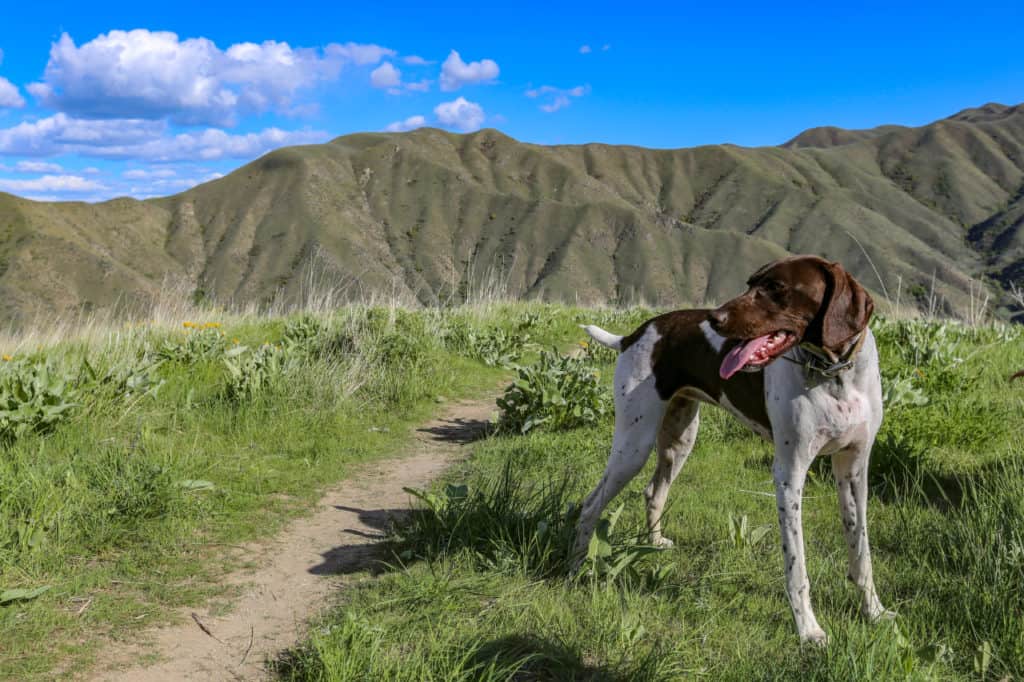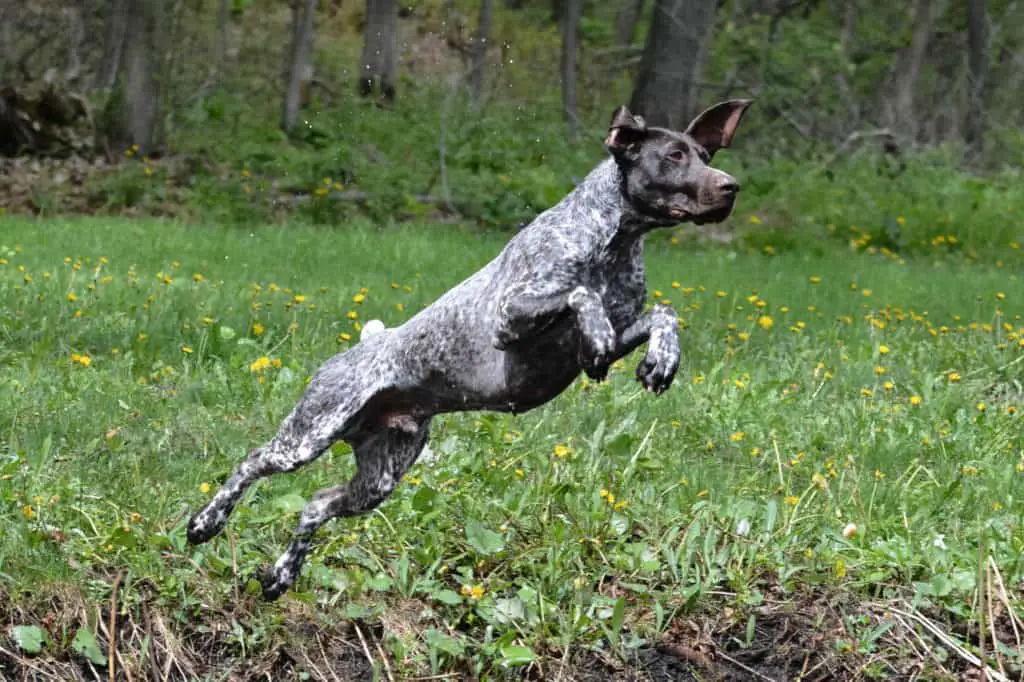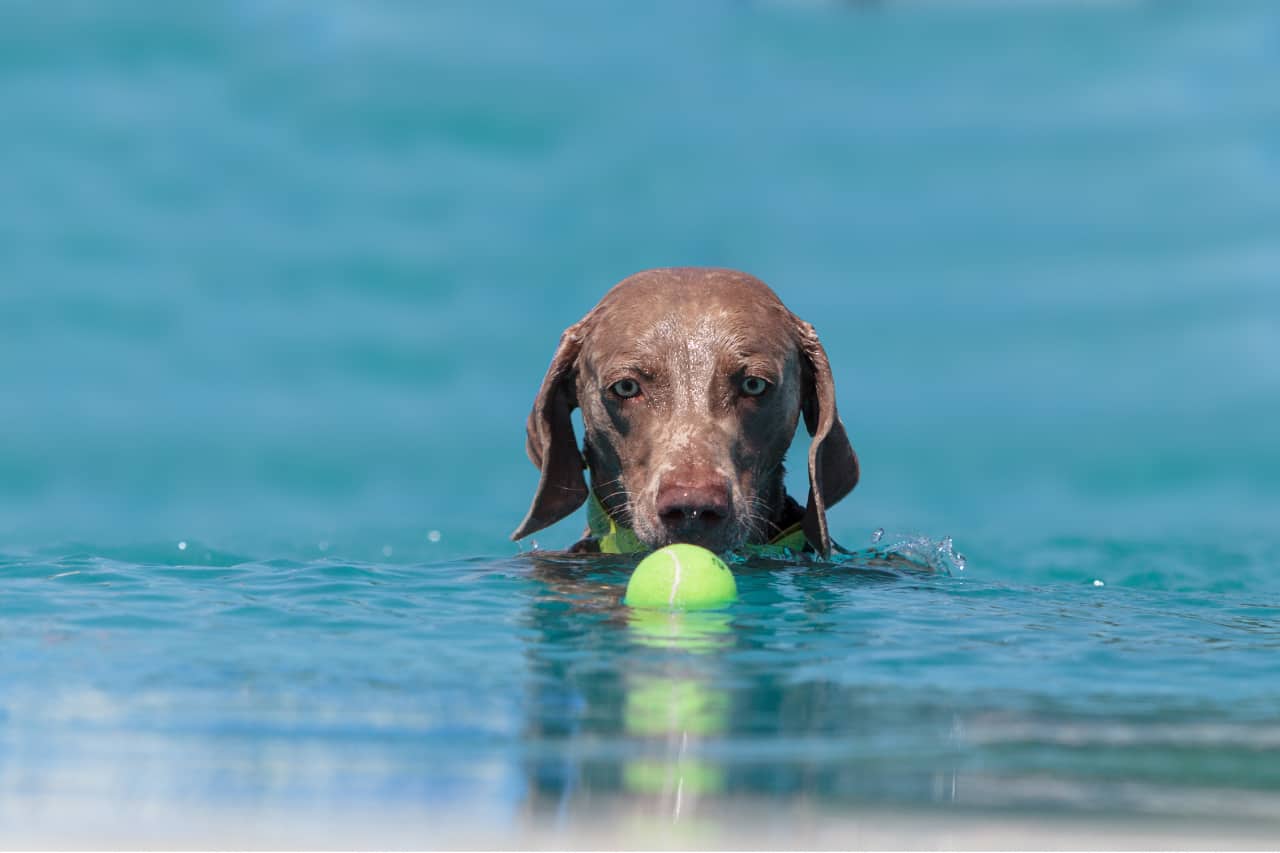German Pointers are high-energy bird dogs. They are bred to spend long hours out in the hunting fields with their owners. This means that they naturally have very high energy levels. High energy levels come with high exercise requirements. A twenty-minute walk in the evenings is not going to cut it for these athletes.
Puppies and senior German Pointers need less exercise than adults. Condition your German Pointer; don’t just start at maximum intensity. Take safety precautions before, during, and after exercise (high-visibility vests, water, drying off, etc.). Pick a form of exercise that you will also be motivated for.
The age of your German Pointer affects how you should exercise them. However, regardless of age, standard safety precautions should be taken before, during, and after exercise sessions. There are also a number of different ways that you can exercise your German Pointer.
Three Different German Pointer Breeds
According to the AKC, there are actually three different breeds of German Pointer. There are the German Shorthaired Pointers, which are probably the most well-known, the German Longhaired Pointers, and the German Wirehaired Pointers.
There are enough differences between these Pointers for them to be classified as different breeds. However, except for the fact that German Longhaired Pointers typically have the lowest energy levels of the three, the same guidelines apply in terms of how to exercise them.
How Much Exercise Do German Pointers Need?
Your German Pointer is going to need different amounts of exercise throughout its life. As puppies and seniors, they cannot or should not be doing as much exercise as they would have in the prime of their life.
How Much Exercise Do German Pointer Puppies Need?
When you have a puppy, you have to find the balance between exercising them to train them, condition them, and use up their energy without letting them overdo it while their joints and muscles mature.
The length of time that your German Pointer falls into the category of puppy is longer than they look like a puppy, so don’t be fooled. Your dog is considered to be a puppy until they are between eighteen months and two years old.
There are no exact rules for exercising your German Pointer puppy—how much, when, what forms, etc. Ideally, you should start with a consult with your veterinarian when you take your puppy for its check-ups. However, there are some common sense-based guidelines that you should follow.
The first guideline is that you should never force your German Pointer puppy to exercise. Unlike certain other dog breeds, German Pointers do not need to be coaxed and coerced into exercising.
If your puppy is sleeping, then let them sleep. If they are playing, then let them play or channel that energy into specific exercises.
The second guideline is that you should stay away from a lot of high-impact exercises. German Pointers are not a small dog breed, and their joints and muscles can become inflamed with too much jolting while they are still maturing.
Agility and obstacle courses that involve jumping should be avoided. Additionally, keep running on hard surfaces, like tar and concrete, to a minimum—instead, take them for short runs around the yard.
The third guideline is that you should not exercise your puppy for too long. How long is too long will depend on your puppy, their age, and the exercise.
You should certainly never push your puppy to the point of exhaustion, but they might be physically able to exercise longer than is good for them, so you will have to monitor this.
If you end up taking your German Pointer puppy for too long a walk one day, don’t fret. Just take note of what was too long and avoid going this long again until they are older and fitter.
The fourth guideline is that you need to be careful where you exercise your German Pointer puppy. Puppies who haven’t been fully vaccinated yet are vulnerable to many diseases that can be carried by other dogs, even if they are not manifesting in that dog.
Parvo is one you might have heard of, and it is a terrible disease will very high mortality rates.
The fifth guideline is to stay observant. If you notice your puppy is all of a sudden hesitant to exercise one day, it may be because they are sore, and you should monitor them or take them to the veterinarian.
If your puppy starts limping at any point during the exercise, stop immediately. If you are out on a walk, don’t let them walk home.
How Much Exercise Do Adult German Pointers Need?
At the absolute minimum, an adult, conditioned German Pointer should get one full hour of high-intensity exercise each day. This is also assuming that the dog has access to a large yard in which they can run around throughout the day.
If your German Pointer does not have access to a yard, then they will likely need multiple exercise sessions of varying intensities every day. This is an intense regimen for anyone, and it is the reason why it is not recommended for German Pointers to live in apartments.
Multi-person homes make it easier because the responsibility can be shared by more than one person. But single-person homes without a large yard are not ideal, especially if the person has a full-time job and does not work from home.
How Much Exercise Do Senior German Pointers Need?
Exercising senior German Pointers also has to be carefully managed. You do not want them to lose condition altogether because strong muscles support frail bones and joints. However, you also do not want to push them to the point where they are in pain or begin to decline faster.
Thankfully, for the most part, your senior German Pointer will slow down naturally. As they are no longer able to do something, they will stop doing it, so you don’t have to force them to stop. Both the exercise intensity and the duration will probably decrease.
However, there might be one or two things that they will continue to try because they are used to doing it, and this can lead to injury. So always be aware of what your old German Pointer is up to and help them to adapt.
Additionally, sometimes, veterinarians will prescribe anti-inflammatories for very old and stiff dogs to ease their discomfort. This may make your German Pointer feel like they can do a lot more exercise again. But you must not be fooled. Their bones are still as old as before, so keep it gentle.
Suppose they seem reluctant to exercise, but your veterinarian recommends that you keep them a little bit active to maintain muscle mass. In that case, you should just encourage them to come with you on gentle walks each day until they really cannot manage even that.

Exercising Your German Pointer Safely
How to exercise your German Pointer is not just about the different ways that you can exercise them or how long and how intense. It also involves what you need to do to make exercise safe.
The following sections look at what safety and protection measures you should take before exercising your German Pointer, what you can do to keep them safe when you are exercising them, and what you need to do after they have been exercising.
What To Do Before Exercising Your German Pointer
Build up your German Pointer’s fitness levels
Just because your German Pointer has loads of energy does not mean that they can be exercised to the maximum duration and intensity from the start. Their musculoskeletal and cardiovascular condition still needs to be built up, just like a human.
Paw and pad protection
Whether you live in the countryside, the suburbs, or the middle of a city, exercising your German Pointer outside poses a risk to their paws and pads.
Things like hot tar and concrete can burn their feet. You will be wearing shoes, so you will not notice if the ground is too hot unless you check with your hands. Make this a part of your exercise routine.
Alternatively, you can try to teach your German Pointer to exercise in booties. These should be comfortable for them and fit properly so that there are no balance, discomfort, and pressure-point issues that arise while your dog exercises.
It’s not just the heat, either. Ice and snow can damage your German Pointers paws. Furthermore, the salt and anti-freeze that are used on sidewalks and roads can chemically burn your German Pointer’s feet.
Booties can also protect their paws and pads from these winter-related hazards, but only use them if your German Pointer is comfortable and happy to wear them.
You can alternatively apply a thin layer of pad balm onto your dog’s pads before going out in the icy weather.
Then there are also hazards like thorns, sharp stones, and broken glass. Once again, booties can help to protect your German Pointer’s paws from getting hurt.
Put a high-visibility vest on your German Pointer
A high-visibility vest is an excellent investment if you exercise your German Pointer outside of your own property. Making your pup more visible to passing drivers is a good idea, whether you are exercise on busy city roads or quiet country lanes.
Put a jacket on your German Pointer
If you live somewhere that has a lot of icy weather, then you need to make sure that your German Pointer is warm enough while exercising but not too bundled up that they overheat. This is mostly applicable to German Shorthaired Pointers.
Ensure that their collar or harness is secure but not uncomfortable
Collars need to be tight enough that your German Pointer cannot slip out of it if something happens, but they also cannot be so tight that they are uncomfortable.
Many people prefer to exercise their German Pointers in a harness because they are harder to slip out of and can be looser while still be safe.
Be prepared
If you are exercising your German Pointer away from home, you need to be prepared for emergencies.
You need to be able to get your dog home or to a veterinarian if they cannot walk. Some people will be strong enough to carry their German Pointer; others will not. In these cases, make sure that you have your cell phone on you so that you can call for a ride.
Take an extra leash in case yours snaps, and always bring water.
Another situation you also have to be prepared to deal with is encountering another dog. People leave their property gates or doors open or lose control of their dog while out exercise. Some even exercise their dogs without a leash when they are not trained well enough for this to be safe.
Whatever the situation, you need to be prepared. This could mean carrying a walking stick or pepper spray or anything else you can think of.
What To Do When Exercising Your German Pointer
Exercise your German Pointer at the right time of the day
In the summer months, rather exercise your German Pointer in the morning and evening to ensure that they do not overheat.
Conversely, in the winter months, rather exercise your dog late morning or afternoon when it is warmer.
Face oncoming traffic
If you are exercising out on a public road, always go in the opposite direction to the traffic. To suddenly have cars coming up behind you can be dangerous, so it is always best to be able to see what’s coming.
Offer your German Pointer water
As noted in the previous section, you should always carry water with you when exercising your German Pointer. But there is no point in carrying it if you forget to offer it to them.
You can bring a collapsible cup with you or simply pour it slowly into your cupped hand while they drink.
Be observant
If your German Pointer is looking tired or if they suddenly go lame, you need to make sure you notice so that you can cut short your exercise session and return home.
What To Do After Exercising Your German Pointer
Wash your German Pointer’s feet
If you have been exercising in the ice and snow, then you need to make sure that your German Pointers feet are washed when you get home. This will remove any packed ice, salt, or anti-freeze (which can poison your dog if they lick their paws).
Dry your German Pointer
If you go out exercising when the ground is snowy and icy, or you get caught in the rain, then make sure that you dry your German Pointer when you return home.
Make sure your German Pointer can cool off
If you have been out in the hot sun for a while, then make sure that your German Pointer has access to shade or even a pool when they get home.
Give your German Pointer water
Make sure that your German Pointer has access to cool, fresh water when they get back from their exercise session. Show them the water and encourage them to drink.
Check your German Pointer’s pads
Always check your German Pointers paws and pads when you get back from exercising outside. Examine them for any cuts or abrasions, and remove any sticks, leaves, etc.

Great Ways To Exercise Your German Pointer
There are so many great exercise techniques to use with your German Pointer, but you need to make sure that you are also committed to whatever you decide to do.
You can change the kind of exercise you do with your German Pointer from day to day, as long as they are being exercised sufficiently each day.
If you are not committed to the exercise, then you are more likely to put it off, cut it short, or neglect it altogether, which is something that you cannot do when you have an energetic Pointer relying on you. It is also why German Pointers are recommended for active owners only.
1. Walking With A German Pointer
Let’s start with the classic method for exercising your dog—walking. Walking does not have to mean a gentle stroll around the block. It can mean a good four- or five-mile walk through the countryside or your neighborhood.
Walking is an excellent choice for German Pointers puppies, seniors, or those who are being conditioned. It’s also a great form of exercise.
Keep things exciting by trying out different routes and doing some safe exploring with your German Pointer.
2. Hiking With A German Pointer
If you love spending your weekends hiking the trails and being in the middle of nature, then do not feel like you have to find someone to dog-sit your German Pointer.
With good training, your Pointer can be the ideal companion for your hiking excursions, even if you are out for most of the day. Just remember to pack supplies for your dog as well as for yourself.
Another great aspect of hiking is that it provides your German Pointer with a whole new set of scents, sights, noises, and textures to explore, engaging them mentally as well as physically.
As hiking is not something you tend to do when you get back from a day at the office, you must remember that your German Pointer will need to be kept in hiking shape with other types of exercises during the week.
3. Running With A German Pointer
If you are a runner, then look no further for the best running companion. German Pointers have the capacity to up with you for a decent number of miles, depending on their age and condition.
You can run with your German Pointer either on-leash or off-leash, but if you are opting for the off-leash option, then make absolutely sure your German Pointer is well-trained. They need to listen when you say stop or come.
In fact, running on a leash requires significant training as well. You are trying to maintain a good and healthy form, so having a wild German Pointer yanking you all over the place is not conducive to a good run.
Running helps your German Pointer achieve the high-intensity exercise they require in a shorter amount of time than other types of exercising.
A third option is to run with a hands-free dog walking belt, which harnesses you to your German Pointer and allows you to run without holding the leash in your hands. This is the best of both worlds option.
4. Cycling With A German Pointer
Cycling with a dog requires a breed that can keep up with the speed, the intensity, and the distance, making the German Pointer a perfect candidate.
Once again, you can go on-leash or off-leash, but training is required to make it a safe practice to cycling while exercising a German Pointer.
If you are holding a leash while you cycle, you can’t have your German Pointer veering off to the side and pulling you right off your bike. They can also get jolted and pulled around if they suddenly start going a different way.
You also have to watch that the leash does not become tangled up in the chain while you cycle.
Off-leash cycling with your German Pointer requires commands like stop, wait, and come absolutely vital. Your German Pointer is a gun dog with a well-developed prey drive so that they may take off after something, in which case, you need to be able to call them back to your side.
Just a quick note on off-leash exercising. Always make sure your dog has its collar and tag on, and always bring a spare leash with you, just in case.
5. Hunting With A German Pointer
What about trying out hunting with your German Pointer? After all, it is what they were designed to do.
As with hiking, however, you will not be coming home from work and going for a quick hunt, so keep up with your German Pointer’s exercise needs with another form of exercise during the week.
If you hunt with a team, then both you and your German Pointer will have the added benefit of social stimulation.
6. Agility With A German Pointer
Agility is a canine sport that involves going through an obstacle course successfully and speedily. Your dog has to be athletic and intelligent—both of which qualities a German Pointer has in abundance.
It’s a great form of exercise to strengthen the bond between you and your dog, too, because you have to work as a team to succeed.
Training for agility will also set you and your German Pointer up with a mid-week exercise regimen, and you prepare for the weekend fun.
7. Dock Diving With A German Pointer
Dock diving is another canine sport in which a dog jumps off a dock into a pool or some other body of water. They win if they jump the furthest.
If you are unable to match your German Pointer’s energy levels, then this one may be the perfect one for you as you stand mostly in one place and your German Pointer runs, jumps, and swims.
8. Swimming With A German Pointer
Not every German Pointer will be a happy swimmer, but many are. If you are having a summertime swim, invite your German Pointer to be part of the fun.
Just make sure that you wash the chlorine off them afterward. Also, some dogs get confused and need to be reminded of where the steps are before they get too tired.
9. Playtime With A German Pointer
A great way to exercise your German Pointer is to simply play games with them. Frisbee, tag, tug-of-war, fetch, etc.
Conclusion
When exercising your energetic German Pointer, you need to know how long they can exercise and at what intensity. This is largely dependent on the age and condition of the dog. Puppies and senior German Pointer can and should do less than an adult Pointer in peak condition.
How to exercise a German Pointer is not just about what techniques or methods are available—even though there are many! Exercising a German Pointer includes making sure that they are safe and protected before, during, and after an exercise session.
References
http://www.vetstreet.com/our-pet-experts/how-much-exercise-is-too-much-for-a-puppy?page=2
https://www.akc.org/dog-breeds/german-wirehaired-pointer/
https://www.akc.org/dog-breeds/german-shorthaired-pointer/
https://www.akc.org/dog-breeds/german-longhaired-pointer/
https://www.akc.org/expert-advice/health/puppies-how-much-exercise/
https://www.rspcapetinsurance.org.au/pet-care/dog-care/how-to-safely-exercise-dog-or-puppy
https://www.runnersworld.com/uk/training/a775126/how-to-run-a-5k-with-your-dog/

